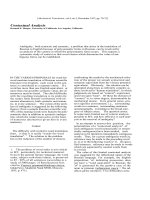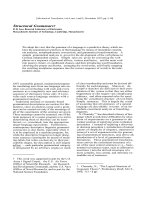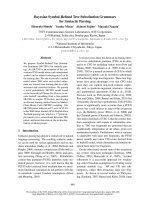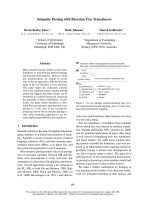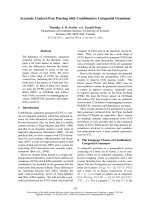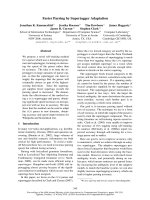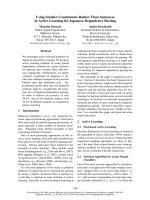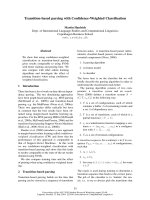Tài liệu Báo cáo khoa học: "Entity-Oriented Parsing" doc
Bạn đang xem bản rút gọn của tài liệu. Xem và tải ngay bản đầy đủ của tài liệu tại đây (551.11 KB, 6 trang )
Entity-Oriented Parsing
Philip J. Hayes
Computer Science Department, Carnegie.Mellon Llniversity
Pi~tsbur~ih, PA 152_13, USA
Abstract f
An entity-oriented approach to restricted-domain parsing is
proposed, In this approach, the definitions of the structure and
surface representation of domain entities are grouped together.
Like semantic grammar, this allows easy exploitation of limited
dolnain semantics. In addition, it facilitates fragmentary
recognition and the use of multiple parsing strategies, and so is
particularly useful for robust recognition of extragrammatical
input. Several advantages from the point of view of language
definition are also noted. Representative samples from an
enlity-oriented language definition are presented, along with a
control structure for an entity-oriented parser, some parsing
strategies that use the control structure, and worked examples
of parses. A parser incorporaling the control structure and the
parsing strategies is currently under implementation.
1.
Introduction
The task of lypical natural language interface systems is much
simpler than the general problem of natural language
understanding: The simplificati~ns arise because:
1. the systems operate within a highly restricted domain of
discourse, so that a preci ~e set of object types c;~n be
established, and many of tl;e ambiguities that come up in
more general natural language processing can be ignored or
constrained away;
2. even within the restricted dolnain of discourse, a natural
language i.terface system only needs to recognize a limited
subset of all the Ihings that could be said the subset that
its back-end can respond to.
The most commonly used tr:chnique to exploit these limited
domain constraints is semantic ~j~amrnar [I, 2, 9] in which
semantically defined categories (such as <ship> or <ship-
attrihute>) are used in a gramrnur (usually ATN based) in place of
syntactic categories (such as <noun> or <adjective>). While
semantic grammar has been very successful in exploiting limited
domain constraint.~ to reduce ambiguities and eliminate spurious
parses of grammatical input, it still suffers from the fragility in the
face of extragrammatical input characteristic of parsing based on
transition nets [41. AI~o. the task of restricted-domain language
definition is typically difficult in interlaces based on semantic
grammar, in part bscaus~ th.,: grammar definition formalism is not
well imegrated with the method of d~ fining the object and actions
of tl~e domain of discourse (though see [6]).
1This r~t,;e~rch wmJ spont;(.cd by the At; Fnrco Office of Scient=fic Resr.,'l¢,";h
und{;r Cow,tract AFOC, R-82-0219
]his paper proposes an alternat;ve approach to restricted
domain langua~fe recognition calI~d entity-oriented p;rsing.
Entity-orie=-ted parsing uses the same notion of semar~tlcally-
defined catctjeries a.', ~2mantic grammar, but does net embed
these cate,:.iories in a grammatical structure designed for sy.tactic
recognition. Instead, a scheme more reminiscent of conceptual or
case.frame parsers [3, 10, II] is employmf. An entity-oriented
parser operates from a collection of definitions of the various
entities (objects. events, cem, m~mds, states, etc.) that a particular
interf:~ce sy-~teln needs to r:.~cognize. These definitions contain
informatiol~ about the internal structure of the entities, about the
way the entitie:~ will be manifested in the natural language input,
s~}(I about the correspondence belween the internal shucture and
surface repres.~ntation. ]his arrangement provides a good
frarnewo~k for exploiting the simplifications possible in restricted
£locY~ain
natt:rnl lanouage recognition because:
1. the entitle:z; form a ~dtural set of !ypes through which to
cun:~train Ih~; recognition semantically. the types also form a
p.alura~ basis fnr the structurctl definitions of entities.
2. the set of things thai the back-end can respond to
corresponds to a subSet of the domain -:-nlities (remember
that entities can be events or commar,ds as well as objects).
Re the f~o~l of an entity.ori,;nted ~ystem will normally be to
recognize one of a "top.ievel" class of entities. This is
analogous to the sot el basic message pa~.terns that Lhe
ir;[~.chin~; translation system of Wilks [11] aimed to recognize
in any input.
In addition to providing a good general basis for restricted
domain n41ural language recognition, we claim that the entity~
o;iented ,~pproach also fa,.;iJitate5 rubu:.;tness in the face of
ex~r~tgrammatical input ~.l~(I ease nf k~guage definition for
ros;r!ctc:l d'm;cJn I~ng~.~Ua:~. EnLity.arie,~ted parsh;g I',.~.s the
potential to provide better parsing robustness Lhan more
traditional semantic gramn~;]r techniques for two major reasons:
• The individual definition of aq domain entities facilit~los their
indepcncl,~mt recoL4rfilion. As:,um;;t,':l there is apl)rof~riaLe
inde'<ing at entiLies tl~rough lex~cai ~toms that mir;iht appt~ar in
a surface dt.'.~cription '.}f them. thi:~ rc.cognitior: c;;n be done
bottom.up, thus rnuking pos:.ible recognition of elliptical,
tru~Fner{~ary, or p~rtially incornpr~.h~;,,siblo input. The same
de~imtions can ~i ;(, be us~cl i~ a m.:.~re eft;cic:nt top-down
f[l;Jt*ll!~:'l
when
t!le input conlorrns to the system's
exDect.alio~]s.
,, Recem work [5, 8] h~ls suggested the usefulness of multiple
cor~structioq.specific reco.qnition str;tt(;gies f,ar restrict,~d
domah] parsing, pat ticularly for dealing witll
extragr;.'nimaiic.q! input. 1 he ir~dividual entity cJo!initlons form
an i(h;al [rc, rnewur}~ arcq~,d which to organize lhr multiple
212
strateg!es. In particular, each definitio~ can specify which
strategies are applicable to recognizing it. Of course, "this
only provides a framework for robust recognition, the
robustness achieved still depends on the quality of the actual
recognition strategies used.
The advantages of entity-oriented parsing for language
definition include:
• All information relating to an entity is grouped in one place,
so that a language definer will be able to see more clearly
whether a dehnition is complete and what would be the
conseouences of any addition or change to the definition.
• Since surface (syntactic) nnd structural information about an
entity is groupe~t to~]ether, tile s,.trface information cau refer
to the structure in a clear al';{] coherent way. In particular,
this allows hierarchical surface information to use the natural
hierarchy defined by the structural informatiol~, leading to
greater consistency of coverage in the surface language.
• Since entity definitions are independent, the information
necessary In drive Jecognilion by the mulliple construction-
spucific strL, tegi~:s mentioned above can be represented
directly in the form most useful to each strategy, thus
removing the need for any kind of "grammar co~pilation"
step and allowing more rapid £irammar development.
In the remainder of the paper, we make these arguments more
concrete by looking at some fragments of an entity-oriented
lan(]u~ge definition, by outlining the control :~truclure of a robust
resUicted-domain parser driven by such defiqitions, and by tracing
through some worked examples of !he parser in operation. These
examples also shown describe some specifi~ parsing strategies
that exploit the control structures. A parser i~=corporating the
control structure and the parsing strategies is currently under
implementation. Its design embodies our e;{perience with ~ pilot
entily-oriented parser that has already been implemented, but is
not described here.
r v 4
.,. ~,,ampie Entity Definitions
This section present'~ .~r)me example eat=t,/ and language
(lefi,fitions suitable for use in entity-oriente(] parsing. The
examples are drawn fi om the Oomain of an in!~rface to a database
of college courses. Here is the (partial) de[initio=~ of a course,
[
Ent ttyNarne : Col legeCourse
type: Structured
Components : (
[Componen tName: £.otlrseNumber
type: Integer
Greater1han : g9
LeSSI I~an : |000
]
[ComponentName : CourseDepartment
lype: Co1 legeDepartment
]
[ C 011ll}0 n e n L N ~ll[le : CourseC I&ss
F3,po : CollegeC lass
]
[CemponentName : Cuurse[nstructo¢
lype: Col|egeProressor
J
)
Silt raceRupresen LaL ion:
[SynLaxfype : NounPhr~se
IIo,l¢l: (course I sesninsr
$CoursoDepartmenL SCour'set, umber I • • • )
AdiectivalCo,lponen£s: (Courseaepartment )
Adjectives: (
JAdjecLiva]Phrase: (new J most. recent)
CotllpOllOn L : CollrseSemos ter
Value: CUI'I t!q LSdm(}S ter
]
i"
PostNomina ICases: (
[PreposiLion: (?intended For J directed to J .)
Cofi|ponellt : CourseClass
J
LPrl:posiLion: (?L~ughL b v I ,)
Colnpollel1 t : Co(~rse [ i1.~ L rllc tot
]
)
J
]
For reasons of space, we cannot explain all the details of this
language. In essence, zz course is definc'd as 3 structured object
with components: number, department, instructor, etc. (square
brackets denote attribute/value lists, and round brackets ordinary
lists). "lhis definition is kept separate from the surface
representation of a course which is defined to be a noun phrase
with adjectives, postnor~irla! cases, etc At a more deiailed level,
note the special purpose way of specifying a course by its
department juxtaposed with its number (e.g. Computer Science
101) is handled by an alternate patt.'.,rn for the head of the noun
phrase (dollar signs refer back to the components). Tiffs allows
the user to s,sy (redur=,~antly) phrases like "CS 101 taught by
Smith". Nolo. also that the way the dep~¢rtment of a course can
appear in the surface representation of a course is specified in
terms of the £:ourseDepartment component (and hence in terms of
its type, Colleg(;Depmln]ent) rather than directly as an explicit
surface representation. This ensures consistency througl~out the
language in what will be recognized as a description of a
department. Coupled wdh the ability to use general syntactic
descriptors (like NounPhrase in the description of a
SurfaceRepresentation), this can prevent the ki~,J of patchy
coveraqe prevalent with standard semantic grammar language
definitions.
Subsidiary objects like CollegeDepartment are defined in similar
fashion.
[
r n t i LyNnmn : £o I I egel)epa v Linen t
|ypo: Er.uiiler'~L ion
E numeratodVa lues : {
Conlptltel SC i,nceDepartment
Ma t hema I. i c sl)el)a r Linen t
II istorylJeparLment
"i"
SurfaceRepresentat ion :
J Syntaxlype: PaLternSet
Patterns: (
[Patt*:rn: (CS I Computer Scie,ce J Camp Sol J )
Va hte : CompuLerSc ietLcel}~lpal'tment
]
)
]
1
213
r;cllegeCoursu will also be involved in higher-level entities ef our
restricted domain such as a cc}mrnan(I to the data base ay.*t:.~m to
+:.rol a student in a course.
[
I Ill. i~l,lalllO: [l)l'O|COlll/ll~tl(I
lype: Structured
Comllonul~ts : (
I.CompononI.Nam+!: Fnrol leo
fypo: CO I I~UeSL.det~L
.I
[CemponenLNamu : I:nee] [n
Type: Co I leg,'~Co,lrse
]
)
Sur f'aceRopr,;se.ta L =el;:
Sy=lta~ [:tp~,: [lll;~.~r.lt. iveC.tsel'ramo
Ilea'J: (corgi I ¢etliSLe¢ ] incl~(le [ )
II i re¢ LObju,: I.: ($E.rol lee)
Cases:
(
[PreposiLi,~n: (in I tote J )
CO;tlpOltOl| L : ~: It I'01 ] I}
]
)
]
]
These examples als~ show how all information about an entity,
co.cerning both tundamental structure and surface
representation, is grouped tooeth',~r al~d integrated. Tiff,.; supports
the claim that entity-c~ri~nted lanuuage definition makes it easier to
deter.nine whether a language definition is complete.
3. Control Structure for a tqcbust Entity-
Oriented Parser
lhe potential advanta.qes of an entily-oriented approach from
tile point of view of robLmtne.~3 in the face of ungr:¢mmatical input
were outlined in the inlrodu(.tion. To exploit this potential while
maintaining efficiency in parsing grammatical input, special
attention must he paid to the control structure of the parser used.
Desirable characteri,=.tics for the control Structure uf ;my parser
capable of handling ungrammatical as well as grammatical input
include:
. the control structure allows grammatical input to be parsed
straightforwardly without consider.ring any of the possible
gralnmatical deviations d;at could occur;
• the om~trol structure enables progr~:,~siw:.ly highP.r degrees of
grammatical (leviatior~ Io be consi(Ic~:.~d when the ilt[~LIt does
not satisfy grammatical exp,~ctations;
• the control structure ;dlows simpler deviatio.s to be
considered before more complex deviations.
]he first two points are self-evident, but the third lll;+ty require
some explanalion. "The r, robl~m it addresses arises particularly
when there are several alternative parses under consideration. In
s.ch cases, it is important to prevent the parser h'om cons!tiering
drastic (levi.xtions in one branch of the par.~'e before cor~si(lering
si~nple ones in the othur. For in::'.ance, tile par.~er sh(;uld not start
hypothesizir=g missing words ir; one bra.ch when a ~;impl,~) sp~flli~l O
correction in another blanch would allow tile parse I¢~ go through.
We have (le-;i(jned a parser control .~hucture for use in e~,tity-
oriented p~.':;in U which i}a~; all
(,~,
the rh;lracteristics lis~e,t above.
Thi.~ control structure operates thrr~u~;h an acJenda mechanism.
Each item of the agenda represents a dii'ier,.:nt
nonU/]uati.on
of the
paine, i.e. a partial parse plus a specificatit,+~ of what to do next to
continue that partial parse, With each cont}nuation is associated
an integer
flexibility level
that represents the degree of
grammatical deviation imphed by the continuation. That is, the
flexibility level represents the degree of grammatical deviation in
the input if the continuation were to produce a complete parse'
without finding any more deviation. Continuations with a lower
flexibility are run before continuations with a higher flexibility level.
Once a complete parse has been obtained, continuations with a,
flexibility level higher than that of the continuation which resulted
in the parse are abandoned. This means that the agenda
mechanism never activates any continuations with a flexibility
level higher than the level representing the lowest level of
grammatical deviation necessary to account for the input. Thus
effort is not wasted exploring more exotic grammatical deviations
when the input can be accounted for by simpler ones. This shows
that the parser has the first two of the characteristics listed above.
In addition to taking care of alternatives at different flexibility
levels, this control structure also handles the more usual kind
of
alternatives faced by parsers those representing alternative
parses due to local ambiguity in the input. Whenever such an
ambiguity arises, the control structure duplicates the relevant
continuation as many times as there are ambiguous alternatives,
giving each of the duplicated continuations the same flexibility
level. From there on, the same agenda mechanism used for the
various flexibility levels will keep each of the ambiguous
alternatives separate and ensure that all are investigated (as long
as their flexibility level is not too high). Integrating the treatment of
the normal kind of ambiguities with the treatment of alternative
ways of handling grammatical deviations ensures that the level of
grammatical deviation under consideration can be kept the same
in locally cmbiguous branches of a parse. This fulfills the third
characteristic listed above.
Flexibility levels are additive, i.e. if some grammatical deviation
has already been found in the input, then finding a new one will
raise the flexibility level of the continuation concerned to the sum
of the flexibility levels involved. This ensures a relatively h!gh
flexibility level and thus a relatively low likelihood of activation for
continuations in which combinations of deviations are being
postulated to account for the input,
Since space is limited, we cannot go into the implementation of
this control structure. However, it is possible to give a brief
description of the control structure primitives used in
programming the parser. Recall first that the kind of entity-
oriented parser we have been discussing consists of a collection
of recognition strategies. The more specific strategies exploit the
idiosyncratic features of the entities/construction types they are
specific to, while the more general strategies apply to wider
cl3sses of entities and depend on more universal characteristics.
In either case, the strategies are pieces of (Lisp) program r~.ther
than more abstract rules or networks. Integration of such
strategies with the general scheme of flexibility levels described
above is made straightforward through a special
split
function
which the control structure supports as a primitive. This split
function allows the programmer of a strategy to specify one or
more alternative continuations from any point in the strategy and
to associate a different flexibility increment with each of them.
214
The implementation of this statement takes care of restarting each
of the alternative continuations at the appropriate time and with
the appropriate local context.
Some examples should make this account of the control
structure much clearer. The examples will also present some
specific parsing strategies and show how they use the split
function described above. These strategies are designed to effect
robust recognition of extragrammatical input and efficient
recognition of grammatical input by exploiting entity-oriented
language definitions like those in the previous section.
4.
Example Parses
t.et us examine first how a simple data base command like:
Enro; Susan Smith in CS 101
might be parsed with the control structure and language
defin;tions presented in the two previous sections. We start off
with the top-level parsing strategy, RecognizeAnyEntity. This
strategy first tries to identify a top-level domain entity (in this case
a data base command) that might account for the entire input. It
does this in a bottom-up manner by indexing from words in the
input to those entities that they could appear in. In this case, the
best indexer is the first word, 'enro!', which indexes
EnrolCommand. In general, however, the best indexer need not
be the first word of the input and we need to consider all words,
thus raising the potential of indexing more than one entity. In our
example, we would also index CollegeStudent, CollegeCourse,
and Co!legeDepartment However, tt'ese are not top.level domain
entities and are subsumed by EnrolCommand, and so can be
ignored in favour of it.
Once EnrolCommand has been identified as an entity that might
account for the input, RecognizeAnyEntity initiates an attempt to
recognize it. Since EnrolCommand is listed as an imperative case
frama, this task is handled by the ImperativeCaseFrame
recognizer strategy. In contrast to the bottom-up approach of
RecognizeAnyEntity, this strategy tackles its more specific task in
a top-down manner using the case frame recognition algorithm
developed for the CASPAR parser [8]. In particular, the strategy
will match the case frame header and the preposition 'in', and
initiate recognitions of fillers of its direct object case and its case
marked by 'in'. These subgoals are to recognize a CollegeStudent
to fill the Enrollee case on the input segment "Susan Smith'" and
a CollegeCourse to fill the Enrolln case on the segment "CS 101 ".
Both of the~e recognitions will be successful, hence causing the
ImperativeCaseFrame recognizer to succeed and hence the entire
recognition. The resulting parse would be:
[InstanceOf :
Enro ICo~nand
£nrol]ee: [InstanceOt': Co]]egeStudent
FirstNaaes : (Susan)
Surname: Smith
]
[nrotZn: []nstance0£: CollegeCourse
EourseDepar tment : Compute rSc I enceDepar tment.
CourseNumber : t01
]
]
Note how this parse result is expressed in terms of the underlying
structural representation used in the entity definitions without the
need for a separate semantic interpretation step.
The last example was completely grammatical and so did not
require any flexibility. After an initial bottom-up step to find a
dominant entity, that entity was recognized in a highly efficient
top-down manner. For an example involving input that is
ungrammaUcal (as far as the parser is concerned), consider:
Place Susan Smith in computer science for freshmen
There are two problems here: we assume that the user intended
'place' as a synonym for 'enror, but that it happens not to be in the
system's vocabulary; the user has a!so shortened the
grammatically acceptable phrase, 'the computer science course
for freshmen', to an equivalent phrasenot covered by the surface
representation for CollegeCourse as defined earlier. Since 'place'
is not a synonym for 'enrol' in the language as presently defined,
the RecognizeAnyEntity strategy cannot index EnrolCommand
from it and hence cannot (as it did in tl~e previous example) initiate
a top-down recognition of the entire input.
To deal with such eventualities, RecognizeAnyEntity executes a
split statement specifying two continuations immediately after it
has found all the entities indexed by the input. The first
continuation has a zero flexibility level increment. It looks at the
indexed entities to see if one subsumes all the others. If it finds
one, it attempts a top-down recognition as described in the
previous example. If it cannot find one, or if it does and the top-
down recognition fails, then the continuation itself fails. The
second continuation has a positive flexibility increment and
follows a more robust bottom-up approach described below. This
second continuation was established in the previous example too,
but was never activated since a complete parse was found at the
zero flexibility level. So we did not mention it. In the present
example, the first continuation fails since there is no subsuming
entity, and so the second continuation gets a chance to run.
Instead of insisting on identifyir,g a single top-level entity, this
second continuation attempts to recognize all of the entities that
are indexed in the hope of later being able to piece together the
various fragmentary recognitions that result. The entities directly
indexed are CollegeStudent by "Susan" and "Smith", 2
CollegeDepartment by "computer" and "science", and
CollegeClass by "freshmen". So a top-down attempt is made to
recognize each of these entities. We can assume these goals are
fulfilled by simple top-down strategies, appropriate to the
SurfaceRepresentation of the corresponding entities, and
operating with no flexibility level increment.
Having recognized the low-level fragments, the second
continuation of RecognizeAnyEntity now attempts to unify them
into larger fragments, with the ultimate goal of unifying them into a
description of a single entity that spans the whole input. To do
this, it takes adjacent fragments pairwise and looks for entities of
which they are both components, and then tries to recognize the
subsuming entity in the spanning segment. The two pairs here are
CollegeStudent and CollegeDepartment (subsumed by
CollegeStudent) and CollegeDepartment and CollegeClass
(subsumed by CollegeCourse).
To investigate the second of these pairings, RecognizeAnyEntity
would try to recognize a CollegeCourse in the spanning segment
'computer science for freshmen' using an elevated level of
flexibility. This gGal would be handled, just like all recognitions of
215
CollegeCourse, by the NominalCaseFrame recognizer. With no
flexibility increment, tiffs strategy fails because the head noun is
missing. However. with another flexibility increment, the
recognition can go through with the CcllegeDepartment being
treated as an adjective and the CollegeClass being treated as a
postnominal case it has the right case marker, "for", and the
adjective and post-nominal are in the right order. This successful
fragment unification leaves two fragments to unify the old
CollegeStudent and the newly derived CollegeCourse.
There are several ways of unifying a CollegeStudent and a
CollegeCourse either could subsume the other, or they could
form the parameters to one of three database modification
commands: EnrolCommand, WithdrawCommand, and
TransferCommand (with the obvious interpretations). Since the
commands are higher level entities than CollegeStudent and
CollegeCourse, they would be preferred as top.level fragment
unifiers. We can also rule out TransferCommand in favour of the
first two because it requires two courses and we only have one. In
addition, a recognition of EnrolCommand would succeed at a
lower Ile×ibility increment than WithdrawCommand, 3 since the
preposition 'in' tilat marks the CollegeCourse in the input is the
correct marker of the Enrolln case of EnrolCommand, but is not
the appropriate marker for WithdrawFrom, the course-containing
case of WithdrawCommand. Thus a fragment unification based
on EnrolCommand would be preferred. Also, the alternate path of
fragment amalgamation combining CollegeStudent and
CollegeDepartment into CollegeStudent and then combining
CoilegeStudent and CollegeCourse that we left pending above
cannot lead to a complete instantiation of a top-level database
command. So RecognizeAnyEntity will be in a position to assume
that the user really intended the EnrolCommand.
Since th~s recognition involved several significant assumptions,
we would need to use focused interaction techniques[7] to
present the interpretation to the user for approval before acting on
it. Note that if the user does approve it, it should be possible (with
further approval) to add 'place' to the vocabulary as a synonym for
'enrol' since 'place' was an unrecognized word in the surface
position where 'enrol' should have been.
For a final example, let us examine an extragrammatical input
that involves continuations at several different flexibility levels:
Transfel Smith from Coi,~pter Science 101 Economics 203
The problems here are that 'Computer' has been misspelt and the
preposition 'to' is missing from before 'Economics'. The example
is similar to the first one in that RecognizeAnyEntity is able to
identify a top-level entity to be recognized top-down, in this case,
TransferCommand. Like EnrolCommand, TransferCommand is an
imperative case frame, and so the task of recognizing it is handled
by the ImperativeCaseFrame strategy. This strategy can find the
preposition 'from', and so can !nitiate the appropriate recognitions
for fillers of the O.tOfCour~e and Student cases. The recognition
for the student case succeeds without trouble, but the recognition
for the OutOfCourse case requires a spelling correction.
2We assume we have a complete listing of students and SO can index from their
names.
Whenever a top-down parsing strategy fails to verify that an
input word is in a specific lexical class, there is the possibility that
the word that failed is a misspelling of a word that would have
succeeded. In such cases, the lexical lookup mechanism
executes a split statement. 4 A zero increment branch fails
immediately, but a second branch with a small positive increment
tries spelling correction against the words in the predicted lexical
class. If the correction fails, this second branch fails, but if the
correction succeeds, the branch succeeds also. In our example,
the continuation involving the second branch of the lexical lookup
is highest on the agenda after the primary branch has failed. In
particular, it is higher than the second branch of
RecognizeAnyEntity described in the previous example, since the
flexibility level increment for spelling correction is small. This
means that the lexical lookup is continued with a spelling
correction, thus resolving the problem. Note also that since the
spelling correction is only attempted within the context of
recognizing a CollegeCourse the filler of OutOfCourse the
target words are limited to course names. This means spelling
correction is much more accurate and efficient than if correction
were attempted against the whole dictionary.
After the OutOfCourse and Student cases have been
successfully filled, the ImperativeCaseFrame strategy can do no
more without a flexibility level increment. But it has not filled all
the required cases of TransferCommand, and it has not used up
all the input it was given, so it splits and fails at the zero-level
flexibility increment. However, in a continuation with a positive
flexibility level increment, it is able to attempt recognition of cases
without their marking prepositions. Assuming the sum of this
increment and the 3pelling correction increment are still less than
the increment associated with the second branch of
RecognizeAnyEntity, this continuation would be the next one run.
In this continuation, the ImperativeCaseFrameRecognizer
attempts to match unparsed segments of the input against unfilled
cases. There is only one of each, and the resulting attempt to
recognize 'Economics 203' as the filler of IntoCourse succeeds
straightforwardly. Now all required cases are filled and all input is
accounted for, so the ImperativeCaseFrame strategy and hence
the whole parse succeeds with the correct result.
For the example just presented, obtaining the ideal behaviour
depends on careful choice of the flexibility level increments.
There is a danger here that the performance of the parser as a
whole will be dependent on iterative tuning of these increments,
and may become unstable with even small changes in the
increments. It is too early yet to say how easy it will be to manage
this problem, but we plan to pay close attention to it as the parser
comes into operatio n .
3This relatively fine distinction between Enro]Command and
Withd~awCemmand. based on the appropriateness of the preposition 'in', is
problem~',tical in that it assumes that the flexibility level would be incremented in
very fine grained steps. If that was impractical, the final outcome of the parse
would be ambiguous between an EnrolCommand and a WithdrawCommand
and
the user would have to be asked to make the discrimination.
4If this
causes too
many splits, an alternative is only to do the split when the
input word in question is not in the
system's lexicon at
all.
216
5.
Conclusion
Entity-oriented parsing has several ~dvantages as a basisfor
language rueognilion in restricted domain natural language
int.£[faces. Like techniques based on semantic grammar, it
ext~loits limited domain semantics through a series of domain-
specific entity types. However, because of its suitability for
fragmentary recogniticn and its ability to accornmodate multiple
construction.specific parsing strategies, it has the i>otential for
greater robustness in the face of extragrammaLical input than the
usu[;I semantic grammar techniques. In this way, it more closely
resembles conceptual or case-frame parsi~lg tc{:t,niques.
Moreover, entity-oriented pursing offers advanta.'jes h:, I:~ngua0e
d~inition because of the integration of struchlr;tl anJ :aurfJ'c~
representutio~z information and the ability to ropr~ sent surta.'.e
information in the form most convenient to drive co+zstruction.
specific recogqifion strategies directly.
A pilot implementation of a~ entity-oriented parser has been
completed and provides preliminary support for our claims.
t4owever, a more rigorous lest of the entity-oriented approach
rnust wait for the more complete implementation <:urrently being
undertaken. ]he agenda-style control structure we plan to use in
this imptementath)~ is described above, along wilh some parsing
sbateGies it will employ and some worked examples of the
sbategies and control structure in action.
Acknowler.igements
I-he ideas in this paper benefited cousiderably from discussions
with other membr~rs of the Multipar group at Carnegie-Mellon
Cnraputer Science Department, parlicu!arly Jaimo CarbonelL Jill
Fain, rod Ste,~e F4inton. Steva Minton was a co-dc~si§ner o! the.
control stru<;tu+e ;~resented att)ov.~:, and also founrl :m efficient w:w
to iruplement the split function de.' cribed in coa+~ec+tion with that
control structure.
References
1. Brown, J. S. and Bt;rton. R. I::l. Multiple Representations of
"Q~owl~dgo for I utoriai Reasoning. In
Repf(~s,'~nt;ttion and
Uod~-:rstan'.'.'mrj,
Bubr,,w, D. ,.G. and Collins, A., Ed.,Academic
Press, New York, 1975, pp. ,311-349.
2. Burton, R. R. Semantic Grammar: An Engineering Technique
for Ccnstructing Natural I.ai%luae, ~ Understanding Systems. BBN
Reporl 3453, Bolt, Beranek, and Newman, Inc., Cambridge, Mass.,
December, 1976.
3. Carbonell, J. G., Boggs, W. M., Mau]din, M. L., and Anick, P. G.
The ×CAI.tBUR Project: A Natural Lan{luage Interface ~o Expert
Systems. Prt;c. Eighth Int. Jt. Conf. on Artificial Intelligence,
Karl.'~ruhe, August, 1983.
4. Carbonell, J. G+ and Hayes, P.J. "Recovery Strategies for
Parsing Extragrammatical Language."
Com~utational Linguistics
10
(t 984).
5. Carbonell, J. G. and 14ayes, P. J. Robust Parsing Using
Multiple Construction-Specific Strategies. In
Natural Language
Pcrsing Systems,
L. Bole, Ed.,Springer-Verlag, 1984.
6. Grosz, B. J. TEAM: A Transport[~ble Nalural Language
Interface System. Prec. Conf. on Applie(I Natural L:~n~tuage
Processing, S'mta Monica, February, 198,3.
7. Hayes P. J. A Construction Specific Approach to Focused
h,teraction in Flexible Parsing. Prec. of 19th Annual Nl~ ,~ting of
the Assoc. for Comp~Jt. ling Stanford University, June, 1981, pp.
149-152.
8.
Hi:yes, P. J. and Ca~t:onell, J. G. lvtulti-Strategy P~r,~i+~g ~;nd its
Role in [~'obust Man. I~,tachin÷.~ Cnmmunicatio'.~. Carnegie-Mellon
IJ~iversity Computer Sc~olJce Department. ,May, 1981.
9. I'lendrix, G. G. Hum~.n Engine+;ring for At)plied Natural
Language Processi~;g. Prec. Fifth Int. Jt. Conf. on Arlificial
Into!l;genc,~., t,.;; r. 1077, pp. 183. ! 91.
IO. i:hes;)e,.;;~. C. K. ao,-I Sch~-nk. R.C. Comprehension by
C'ompuLr~r:
Expectation.[lase, l
An;.tly:,;3 el S~nteac+~G irt Context.
rech. Ru'pL 7~5, C, omputc;r Science Dept., Y£1e Uoiveruity, 1976.
1 I. W~lks, ?. A. Prefere:-,ce Semantics. In
F-ormal Semantics of
IV~tural L~.ngu:zge ,
Keer;an, k(I Can}bridge University Press, 1975.
217
